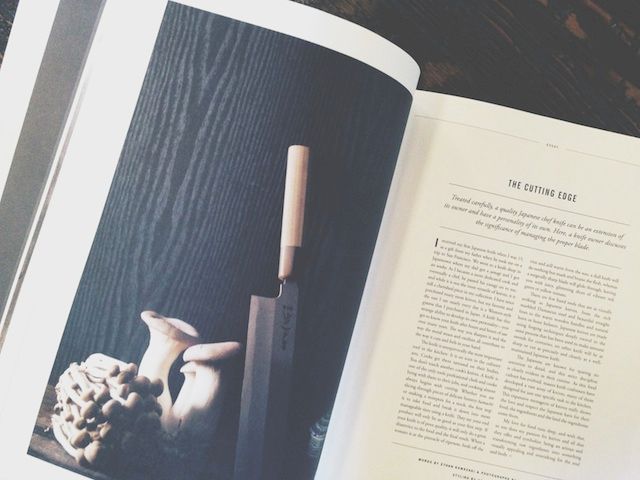On what software designers can learn from Japanese knife makers.

From Kinfolk, Volume Eight: The Cutting Edge, by Ethan Kawasaki.
The knife is unequivocally the most important tool in the kitchen: It is an icon in the culinary arts. Cooks get them tattooed on their bodies. You don’t touch another cook’s knives. A knife is one of the only tools professional chefs and cooks bring with them to their jobs, and cooking almost always begins with cutting.
and on the craft of making tools that honor, respect, and inspire love:
The Japanese are known for sparing no attention to detail, and this strict discipline is clearly evident in their cuisine. As this food culture has evolved, master knife craftsmen have developed a vast array of knives, many of them designed for just one specific task in the kitchen. This expansive menagerie of knives really shows the love and respect the Japanese have for their food, the ingredients, and the land the ingredients come from.
What, I wonder, can software designers, also tool makers, learn from master Japanese knife craftsmen? Simplicity. Focus. Attention-to-detail. Beauty. Pride in craftsmanship. How to build tools to love.
–––––––
On that note, one day I will buy a Japanese knife, and use it to slice peaches for this peach raspberry tart:
Serves 6 to 8
For the pastry dough:
1 1/2 cup flour
3/4 teaspoons salt
1/4 cup sugar
6 ounces cold butter, cut into pieces
3 tablespoons ice cold waterFor the fruit filling:
4 peaches, peeled and sliced (see note)
1/2 pint, raspberries
2 tablespoons butter, cut into pieces
1/4 cup sugar1 Place a rimmed baking sheet onto the center rack of the oven. Preheat oven to 400º.
2 To make the pastry dough, add the flour, salt and sugar to a deep bowl; whisk to combine. Scatter the butter pieces over flour mixture and use a pastry blender, two butter knives or your fingers to cut in the butter (this can alternately be done in a food processor). Sprinkle the cold water over the butter-flour mixture and stir with a fork until the dough forms a rough ball. Wrap in plastic and let rest in the refrigerator for 20 to 30 minutes.
3 On a lightly floured piece of parchment paper, roll the dough out into a 16-inch circle. Scatter the fruit over the dough, leaving a 4-inch border. Sprinkle the sugar over the fruit and dot with the pieces of remaining butter. Fold the dough border up and over to cover the fruit, forming a crust. Leaving the tart on the parchment paper, place it on the heated baking sheet. Bake 40 to 45 minutes, or until pastry is a deep golden and the fruit is bubbling in the center. Let cool for 10 to 15 minutes. Serve warm or at room temperature.